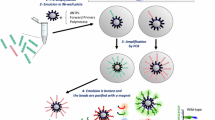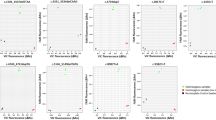Abstract
Large insertions/deletions mutations are frequently found in genes associated with certain diseases such as hereditary cancers. These mutations are mostly overlooked by current classical screening techniques due to their certain limitations. This justifies the need to improve the existing techniques or design novel ones. A modified version of quantitative multiplex PCR short fluorescent fragment (QMPSF), termed universally primed QMPSF (upQMPSF), was developed. The modifications enhance multiplexing capacity, reduce cost, and improve the mutation detection spectrum. upQMPSF was used to screen germline mutations in 88 familial ovarian cancer patients negative for point mutations. upQMPSF successfully detected a 2.8 kb copy number gain spanning exon 15 of BRCA1 gene mediated by Alu–Alu homologous-based recombination. upQMPSF is a cost-efficient, versatile method, and demonstrated efficiency in detecting structural variations as a potential method for genetic testing in clinical and research laboratories.








Similar content being viewed by others
References
Baumann P, West SC (1998) Role of the human RAD51 protein in homologous recombination and double-stranded-break repair. Trends Biochem Sci 23:247–251
Bishop AJ, Schiestl RH (2000) Homologous recombination as a mechanism for genome rearrangements: environmental and genetic effects. Hum Mol Genet 9:2427–2434
Casilli F, Di Rocco ZC, Gad S, Tournier I, Stoppa-Lyonnet D, Frebourg T, Tosi M (2002) Rapid detection of novel BRCA1 rearrangements in high-risk breast-ovarian cancer families using multiplex PCR of short fluorescent fragments. Hum Mutat 20:218–226
Charbonnier F, Raux G, Wang Q, Drouot N, Cordier F, Limacher JM, Saurin JC, Puisieux A, Olschwang S, Frebourg T (2000) Detection of exon deletions and duplications of the mismatch repair genes in hereditary nonpolyposis colorectal cancer families using multiplex polymerase chain reaction of short fluorescent fragments. Cancer Res 60:2760–2763
Collins FS (1996) BRCA1—lots of mutations, lots of dilemmas. N Engl J Med 334:186–188
Cousineau I, Abaji C, Belmaaza A (2005) BRCA1 regulates RAD51 function in response to DNA damage and suppresses spontaneous sister chromatid replication slippage: implications for sister chromatid cohesion, genome stability, and carcinogenesis. Cancer Res 65:11384–11391
Gu W, Zhang F, Lupski JR (2008) Mechanisms for human genomic rearrangements. Pathogenetics 1:4
Kalendar R, Lee D, Schulman AH (2009) FastPCR software for PCR primer and probe design and repeat search. Genes Genomes Genomics 3:1–14
Kent WJ, Sugnet CW, Furey TS, Roskin KM, Pringle TH, Zahler AM, Haussler D (2002) The human genome browser at UCSC. Genome Res 12:996–1006
Li L, McVety S, Younan R, Liang P, Du Sart D, Gordon PH, Hutter P, Hogervorst FB, Chong G, Foulkes WD (2006) Distinct patterns of germ-line deletions in MLH1 and MSH2: the implication of Alu repetitive element in the genetic etiology of Lynch syndrome (HNPCC). Hum Mutat 27:388
Lupski JR (2007) Genomic rearrangements and sporadic disease. Nat Genet 39:S43–S47
Lynch HT, Casey MJ, Lynch J, White TE, Godwin AK (1998) Genetics and ovarian carcinoma. Semin Oncol 25:265–280
Mazoyer S, The BRCA1 Exon 13 Duplication Screening Group (2000) The exon 13 duplication in the BRCA1 gene is a founder mutation present in geographically diverse populations. Am J Hum Genet 67:207–212
Petrij-Bosch A, Peelen T, van Vliet M, van Eijk R, Olmer R, Drüsedau M, Hogervorst FB, Hageman S, Arts PJ, Ligtenberg MJ, Meijers-Heijboer H, Klijn JG, Vasen HF, Cornelisse CJ, van’t Veer LJ, Bakker E, van Ommen GJ, Devilee P (1997) BRCA1genomic deletions are major founder mutations in Dutch breast cancer patients. Nat Genet 17:341–345
Pharoah PD, Ponder BA (2002) The genetics of ovarian cancer. Best Pract Res Clin Obstet Gynaecol 16:449–468
Puget N, Sinilnikova OM, Stoppa-Lyonnet D, Audoynaud C, Pagès S, Lynch HT, Goldgar D, Lenoir GM, Mazoyer S (1999) An Alu-mediated 6-kb duplication in the BRCA1 gene: a new founder mutation? Am J Hum Genet 64:300–302
Ramus SJ, Harrington PA, Pye C, DiCioccio RA, Cox MJ, Garlinghouse-Jones K, Oakley-Girvan I, Jacobs IJ, Hardy RM, Whittemore AS, Ponder BA, Piver MS, Pharoah PD, Gayther SA (2007) Contribution of BRCA1 and BRCA2 mutations to inherited ovarian cancer. Hum Mutat 28:1207–1215
Schouten JP, McElgunn CJ, Waaijer R, Zwijnenburg D, Diepvens F, Pals G (2002) Relative quantification of 40 nucleic acid sequences by multiplex ligation-dependent probe amplification. Nucleic Acids Res 30:e57
Shattuck-Eidens D, McClure M, Simard J, Labrie F, Narod S, Couch F, Hoskins K, Weber B, Castilla L, Erdos M, Brody L, Friedman L, Ostermeyer E, Szabo C, King M, Jhanwar S, Offit K, Norton L, Gilewski T, Lubin M, Osborne M, Black D, Boyd M, Steel M, Ingles S, Haile R, Lindblom A, Olsson H, Borg A, Bishop T et al (1995) A collaborative survey of 80 mutations in the BRCA1 breast and ovarian cancer susceptibility gene. Implications for presymptomatic testing and screening. JAMA 273:535–541
Smith TM, Lee MK, Szabo CI, Jerome N, McEuen M, Taylor M, Hood L, King MC (1996) Complete genomic sequence and analysis of 117 kb of human DNA containing the gene BRCA1. Genome Res 6:1029–1049
van der Klift H, Wijnen J, Wagner A, Verkuilen P, Tops C, Otway R, Kohonen-Corish M, Vasen H, Oliani C, Barana D, Moller P, Delozier-Blanchet C, Hutter P, Foulkes W, Lynch H, Burn J, Möslein G, Fodde R (2005) Molecular characterization of the spectrum of genomic deletions in the mismatch repair genes MSH2, MLH1, MSH6, and PMS2 responsible for hereditary nonpolyposis colorectal cancer (HNPCC). Genes Chromosomes Cancer 44:123–138
Wooster R, Stratton MR (1995) Breast cancer susceptibility: a complex disease unravels. Trends Genet 11:3–5
Wooster R, Weber BL (2003) Breast and ovarian cancer. N Engl J Med 348:2339–2347
Acknowledgments
This research was supported in part by Gynecology Oncology Foundation and Roswell Alliance Foundation. Special thanks to Dr. Ping Liang for guiding this research and Dr. Richard DiCioccio for providing the ovarian cancer patient samples from Gilda Radner Ovarian Cancer Registry (GROCR) at Roswell Park Cancer Institute (RPCI). Also thanks to Dr. William Foulkes.




